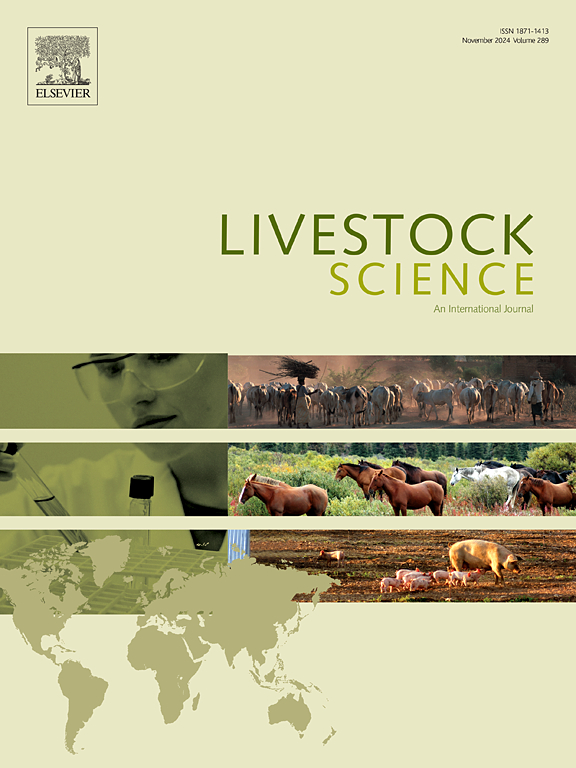Genetic parameters for the occurrence of bovine viral diarrhea virus in Holstein cattle in Brazil
IF 1.9
3区 农林科学
Q2 AGRICULTURE, DAIRY & ANIMAL SCIENCE
引用次数: 0
Abstract
Bovine viral diarrhea virus (BVDV) is a significant infectious disease that affects livestock worldwide and is primarily associated with reproductive problems. Due to the absence of studies that have determined genetic parameters for the disease, the aim of this study was to estimate the heritability coefficient for the occurrence of BVDV and the correlation between estimated breeding values (EBVs) for BVDV and EBVs for productive, reproductive, and health traits in Holstein dairy cattle in Brazil. 18,464 BVDV phenotypes from animals tested between September 2015 and June 2021 across 8 commercial dairy farms were provided by the Holstein Cattle Breeders Association of Parana State, Brazil. Animals with an ELISA antigen test equal to or greater than 0.3 were classified as BVDV positive, and the prevalence of the disease was determined. For the genetic analyses, 6,202 phenotypes were used. Heritability coefficient and EBVs were estimated using a threshold animal model with GIBBSF90+ software, considering as fixed the effect of the class of animal's age (calves, from 1 to 183 days old; young animals, from 184 to 365 days old; heifers, from 366 to 599 days old; primiparous cows, from 600 to 1,000 days old; and multiparous cows, from 1,001 to 3,650 days old), as random the effect of the contemporary group (herd-year-season of the test), direct additive genetic, and residual. Pearson correlations were performed among the EBVs of bulls estimated for BVDV and the EBVs for productive, reproductive and health traits obtained from the Council on Dairy Cattle Breeding database. The overall prevalence of BVDV infection was 2.56 %. The estimated heritability was 0.18±0.09, suggesting some genetic variability. Most of the correlation estimates among EBVs were negative, non-significant, and close to zero. However, the estimates among BVDV and some traits were low-magnitude, negative, and significant (P<0.05) as Productive Life (-0.13), Daughter Pregnancy Rate (-0.07), Cow Conception Rate (-0.11), Cow Livability (-0.15), Displaced Abomasum (-0.11), Ketosis (-0.06), Mastitis (-0.09), and Feed Saved (-0.07). Therefore, genetic selection has limited potential in addressing the occurrence of BVDV. Nevertheless, it is recognized that the combination of disease eradication protocols with better-organized recording of phenotypes in herds could enable farms to improve herd health and animal welfare.
巴西荷斯坦牛发生牛病毒性腹泻病毒的遗传参数
牛病毒性腹泻病毒(BVDV)是一种影响全世界牲畜的重要传染病,主要与生殖问题有关。由于缺乏确定该疾病遗传参数的研究,本研究的目的是估计BVDV发生的遗传系数以及BVDV的估计育种值(ebv)与ebv在生产、繁殖和繁殖方面的相关性。2015年9月至2021年6月期间,巴西巴拉那州荷斯坦牛饲养者协会在8个商业奶牛场对动物进行了18464种BVDV表型测试。ELISA抗原测试值等于或大于0.3的动物被分类为BVDV阳性,并确定该疾病的患病率。在遗传分析中,使用了6202种表型。遗传系数和ebv使用阈值动物模型与GIBBSF90+软件进行估计,考虑动物年龄类别(犊牛,1 ~ 183日龄;幼龄动物,从184天到365天;366 ~ 599日龄的小母牛;初产母牛,出生600至1000天;而多产奶牛,从1001 ~ 3650日龄),作为随机影响的当代组(畜群年季的测试),直接加性遗传,和残余。在公牛的BVDV估计值与奶牛育种委员会数据库中获得的生产、繁殖和健康特征的ebv之间进行Pearson相关性分析。BVDV总感染率为2.56%。遗传率为0.18±0.09,存在一定的遗传变异性。ebv之间的大多数相关性估计是负的,不显著的,接近于零。然而,BVDV和一些性状之间的估计值为低、负且显著(P<0.05),如生产寿命(-0.13)、女胎妊娠率(-0.07)、奶牛受孕率(-0.11)、奶牛存活率(-0.15)、皱胃移位(-0.11)、酮症(-0.06)、乳腺炎(-0.09)和节省饲料(-0.07)。因此,遗传选择在解决BVDV发生方面的潜力有限。然而,人们认识到,将疾病根除方案与更好地组织畜群表型记录相结合,可以使农场改善畜群健康和动物福利。
本文章由计算机程序翻译,如有差异,请以英文原文为准。
求助全文
约1分钟内获得全文
求助全文
来源期刊

Livestock Science
农林科学-奶制品与动物科学
CiteScore
4.30
自引率
5.60%
发文量
237
审稿时长
3 months
期刊介绍:
Livestock Science promotes the sound development of the livestock sector by publishing original, peer-reviewed research and review articles covering all aspects of this broad field. The journal welcomes submissions on the avant-garde areas of animal genetics, breeding, growth, reproduction, nutrition, physiology, and behaviour in addition to genetic resources, welfare, ethics, health, management and production systems. The high-quality content of this journal reflects the truly international nature of this broad area of research.
 求助内容:
求助内容: 应助结果提醒方式:
应助结果提醒方式:


